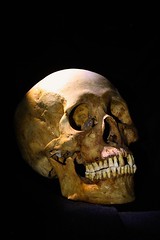 Two skeletons of sailors were found on the USS Monitor when it was raised from the ocean floor. DNA testing has failed to produce a match with the sailors’ living descendants. Forensic facial reconstruction is now being done, in the hopes of identifying the unknown sailors, and perhaps finding their families.
Two skeletons of sailors were found on the USS Monitor when it was raised from the ocean floor. DNA testing has failed to produce a match with the sailors’ living descendants. Forensic facial reconstruction is now being done, in the hopes of identifying the unknown sailors, and perhaps finding their families.
The USS Monitor was an ironclad ship that was used by the Union during the Civil War. The ship has been described as a “cheese box on a raft”. It was not designed to withstand sailing on rough water, and it was being towed by the USS Rhode Island when it sank. There was a total of 62 crew members on the USS Monitor. The USS Rhode Island was able to rescue around 50 of them. Sixteen men died that day.
In 1973, the wreck of the USS Monitor was discovered on the ocean floor. In 1975, it was designated the first national marine sanctuary. Around ten years ago, someone managed to retrieve the ship’s revolving turret. You can go see it. It is on display at the USS Monitor Center of the Mariners’ Museum.
The skeletons of two crew members were discovered when the turret was raised from the bottom of the ocean. Each was clothed in the tattered remains of their uniforms. One had a rubber comb, and the other one had a ring on one of his fingers.
Who were these unknown sailors? DNA samples were taken from the teeth and leg bones of the sailors. This was tested, but it failed to result in a match with anyone who was a living descendant of either man. There wasn’t much of anything that could be learned about these two men by the comb or the ring that was found on their skeletons.
There is still hope, however. Experts at the Louisiana State University are doing forensic facial reconstructions on the skulls of the skeletons of the unknown sailors. The hope is that this could lead to a more definitive identification about who these sailors were. From there, perhaps a descendant could be found.
Scientists were able to learn a few things by comparing the skeletons to information that can be found in documents that give details about who the crew of the USS Monitor was at the time when it sank. They know that the skeletons were of Caucasian men, so this rules out the possibility of either skeleton belonging to one of the three African-Americans who served on the ship.
The skeletons also show that one man was somewhere between the ages of 17 and 24, and that the other one was in his 30’s. When the scientists examined medical and Navy records from the time, they were able to narrow things down even further. The younger man could be one of four people, and the older man could be one of two crew members.
Something unique about the skeleton of the older man was noted. One of his legs was shorter than the other. The medical records of one crew member sometimes showed that he was 5′ 8”, and other times showed that he was 5′ 8” and half. Could that be caused by the man favoring the shorter leg sometimes, and the longer leg other times when a doctor measured his height?
If so, then his name might very well be Robert Williams. Due to his incredibly common surname, the scientists have been unable to locate the man’s descendants, in order to let them know about him. Maybe the facial reconstructions will help with identifying the living descendants of these two unknown sailors.
Image by Ray Myint on Flickr

